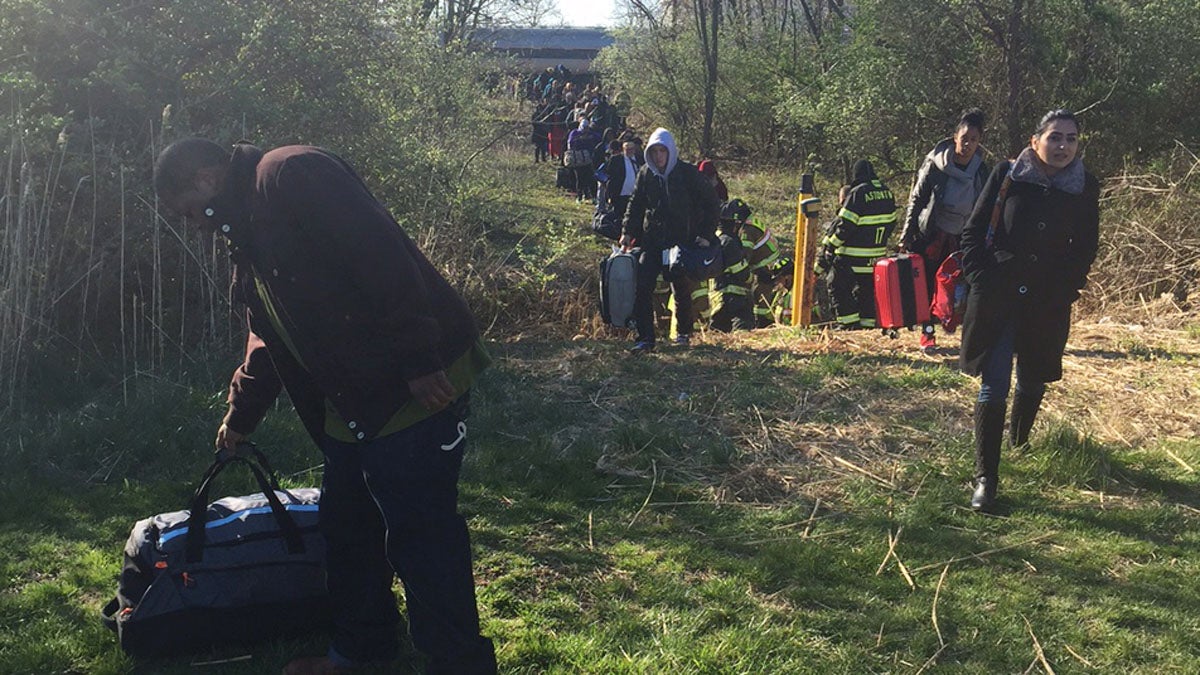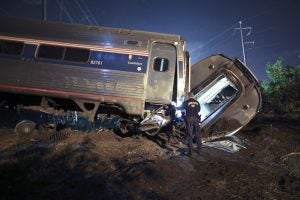Amtrak ordered to retrain workers following deadly crash outside Philly
The mandate from the Federal Railroad Administration suggests the veteran Amtrak workers may not have known the track was being reopened to train traffic.

Passengers leave an Amtrak train following a deadly crash Sunday in Chester, Pennsylvania. The Amtrak train struck a piece of construction equipment just south of Philadelphia, killing two workers and causing a derailment. (Maggie Holtgreive via AP)
Amtrak has been ordered to retrain rail workers on basic safety rules days after a train going 106 mph struck and killed two Amtrak employees working on the same track.
The mandate from the Federal Railroad Administration suggests the veteran Amtrak workers may not have known the track was being reopened to train traffic.
The directive, in bold print, orders Amtrak to reinforce the rule that a track will not be reopened until all workers have either left the area or been warned about an approaching train.
The engineer on the southbound Palmetto train Sunday had only five seconds to brake before crashing into a backhoe occupying the same track in Chester, about 15 miles south of Philadelphia. Backhoe operator Joseph Carter Jr., 61, of Wilmington, Delaware, and supervisor Peter Adamovich, 59, of Lincoln University, Pennsylvania, were killed.
About 30 of the more than 300 passengers aboard were injured, most with scrapes and bruises.
The National Transportation Safety Board, the lead agency investigating the crash, expects to issue preliminary findings within 10 days.
However, the directive issued Wednesday suggests the collision must have followed a breakdown in communication, possibly during a shift change. The crash occurred just before 8 a.m.
“FRA rules always require that a notification be made to the workers before there are any changes to their job briefing” and the track goes into service, the agency directive said.
Amtrak Chairman Joe Boardman promised to comply with the order to remind workers of “the seriousness of following our rules to prevent accidents, injuries and deaths.”
“We will begin the safety stand down immediately with all active crews,” Boardman said in a statement Thursday.
With the deaths on Sunday, that makes three track workers who have been killed on the job on Amtrak’s Northeast Corridor since March 1, according to their union.
The federal safety directive also described secondary safety measures Amtrak should consider to prevent crashes, including the use of a device called a “shunt” that sends an electronic signal to the dispatcher when machinery is on the track. The use of the devices were debated after a similar crash in Chester in 1988, in which two track workers jumped to safety before an oncoming train struck their maintenance vehicle.
In Sunday’s crash, three contract employees were using a machine to do stone work on an adjacent track when the train struck the backhoe, a company spokesman said. They were working in tandem with the Amtrak crew, and were “unaware” the other track was in service, according to Tom DeJoseph, a spokesman for the company, Loram Maintenance of Way.
During a shift change, the outgoing supervisor is supposed to brief the incoming supervisor, who then meets with his or her crew before anyone enters the track, rail safety experts said. The supervisors also communicate with Amtrak dispatchers.
“The procedures were in place, and somebody did not follow them,” said consultant Russell Quimby, a retired NTSB safety engineer who is not involved in the investigation.
WHYY is your source for fact-based, in-depth journalism and information. As a nonprofit organization, we rely on financial support from readers like you. Please give today.


